edited 1/1/2021: Please read through this whole thread . This binding adaption is a work in progress and has been refined a number of times. The main principle of using the voile strap and the telemark cables on the front piece of the Receptor is effective and works well . I have been working on a variety of different ways to provide a heel lifter which are detailed in the ensuing posts. I have also discussed using a less expensive and yet equally effective telemark cable in the posts that follow. Here is a picture of my current recommended set up. The crampon receiver is set up forward of the toe in this picture but it can also be set up underneath the boot depending on the length of your boot and whether you want set back or not..
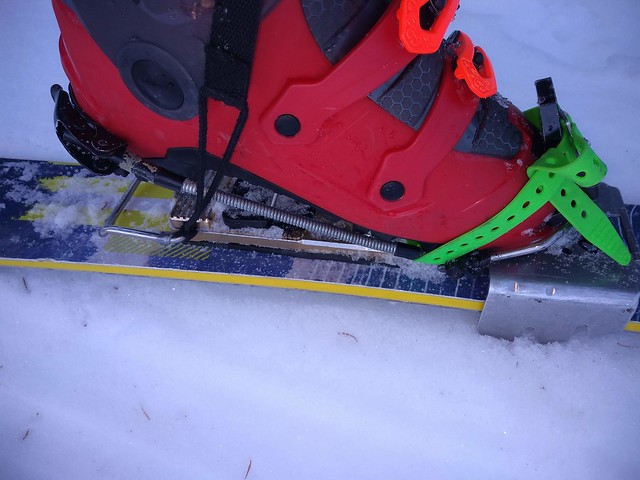 IMG_20210117_095228942 by Jack Jue Jr, on Flickr
IMG_20210117_095228942 by Jack Jue Jr, on Flickr
Below is my original post.
I have come up with an easy way to modify the RVL8 receptor binding to allow touring in the backcountry.
Anyone can use their Receptor binding to tour on any RVL8 skiboard by purchasing these commercially available supplies.
2 long Voile plastic straps
2 Voile Telemark cables
2 Two inch tall pieces of pvc pipe drilled with a hole on either side to pull elastic cord through
two pieces of elastic cord
Climbing skins
A pair of Skeats strap on mini crampons.
Here is a picture of the binding in touring mode with heel elevator engaged
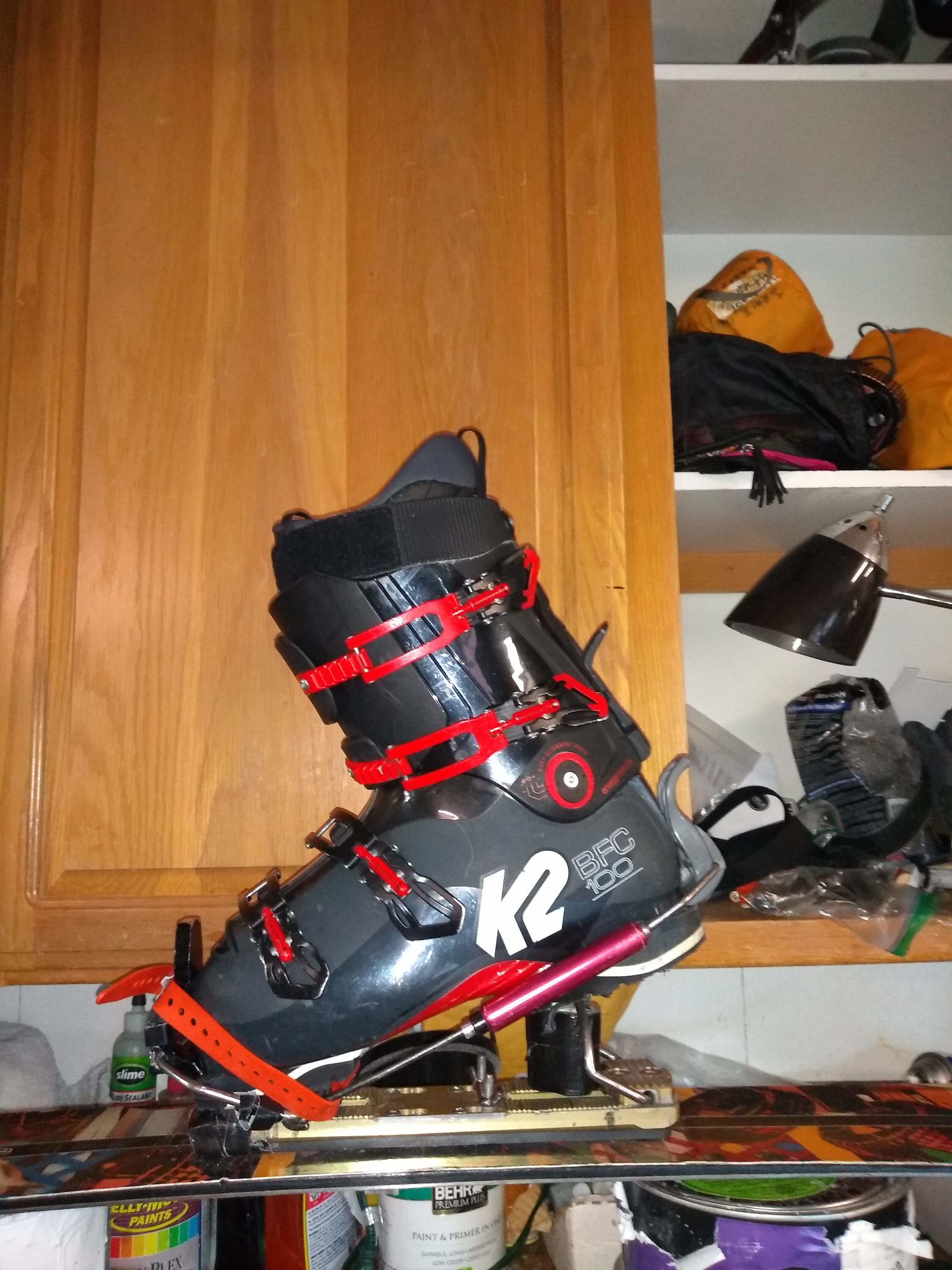 IMG_20201226_082219798 by Jack Jue Jr, on Flickr
IMG_20201226_082219798 by Jack Jue Jr, on Flickr
Ok here is how to get into the binding in touring mode
you simply attach the hooks of the telemark cables to the front bale of the Receptor binding. I put some duct tape permanently near where the bale bends into the foot plate to keep the telemark cables from shifting when I am getting into the binding.
I lay the voile strap just behind the foot receptor foot plate and then attach the regular front bale and rear telemark cable to my boot.
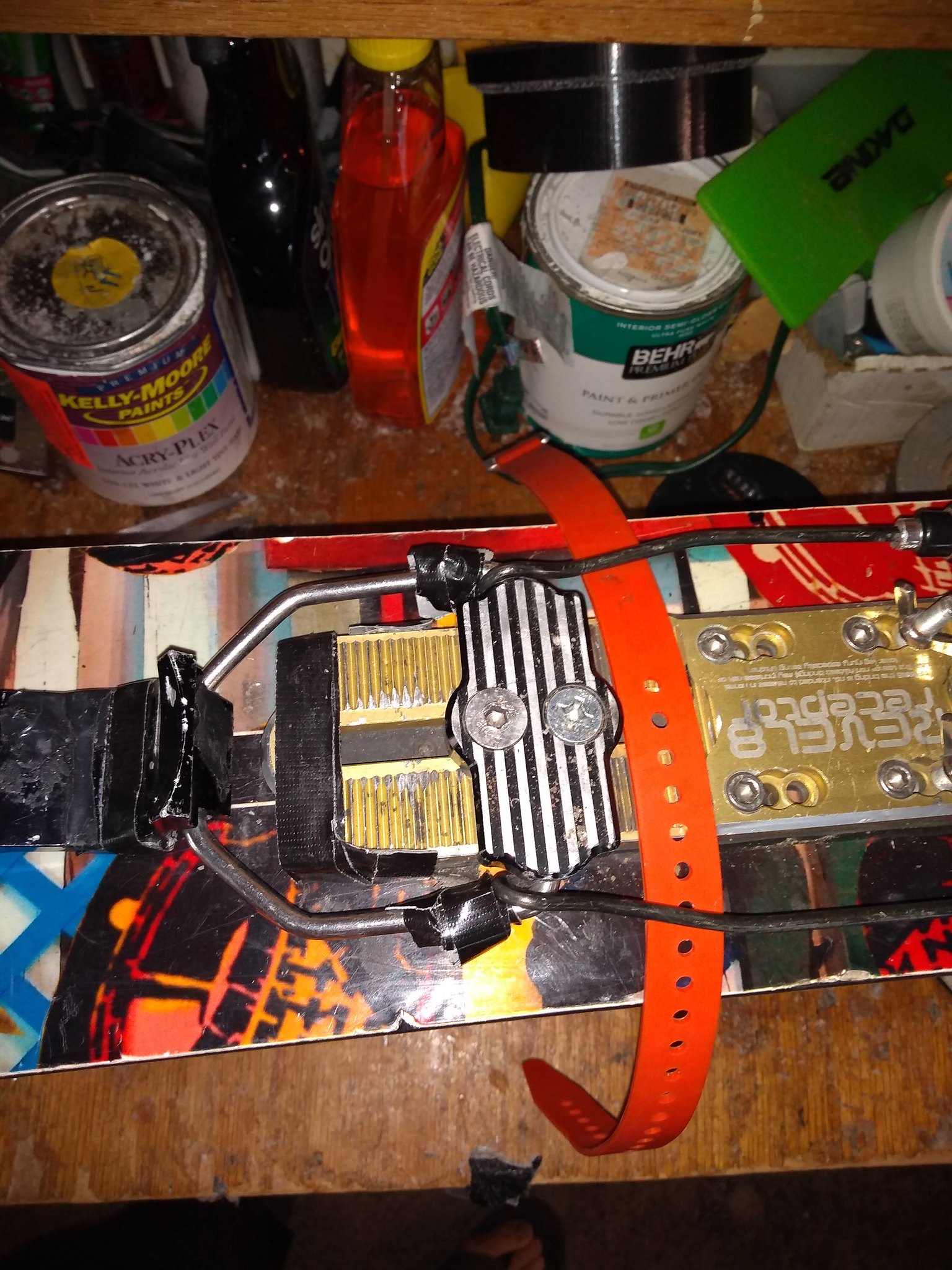 IMG_20201226_082304627 by Jack Jue Jr, on Flickr
IMG_20201226_082304627 by Jack Jue Jr, on Flickr
 IMG_20201226_083029075 by Jack Jue Jr, on Flickr
IMG_20201226_083029075 by Jack Jue Jr, on Flickr
I then pull the strap around my boot and around the front bale and tighten the voile strap. This is really what makes this system work because it keeps the front lever
from snapping open on climbing which happened on previous iterations of this binding.
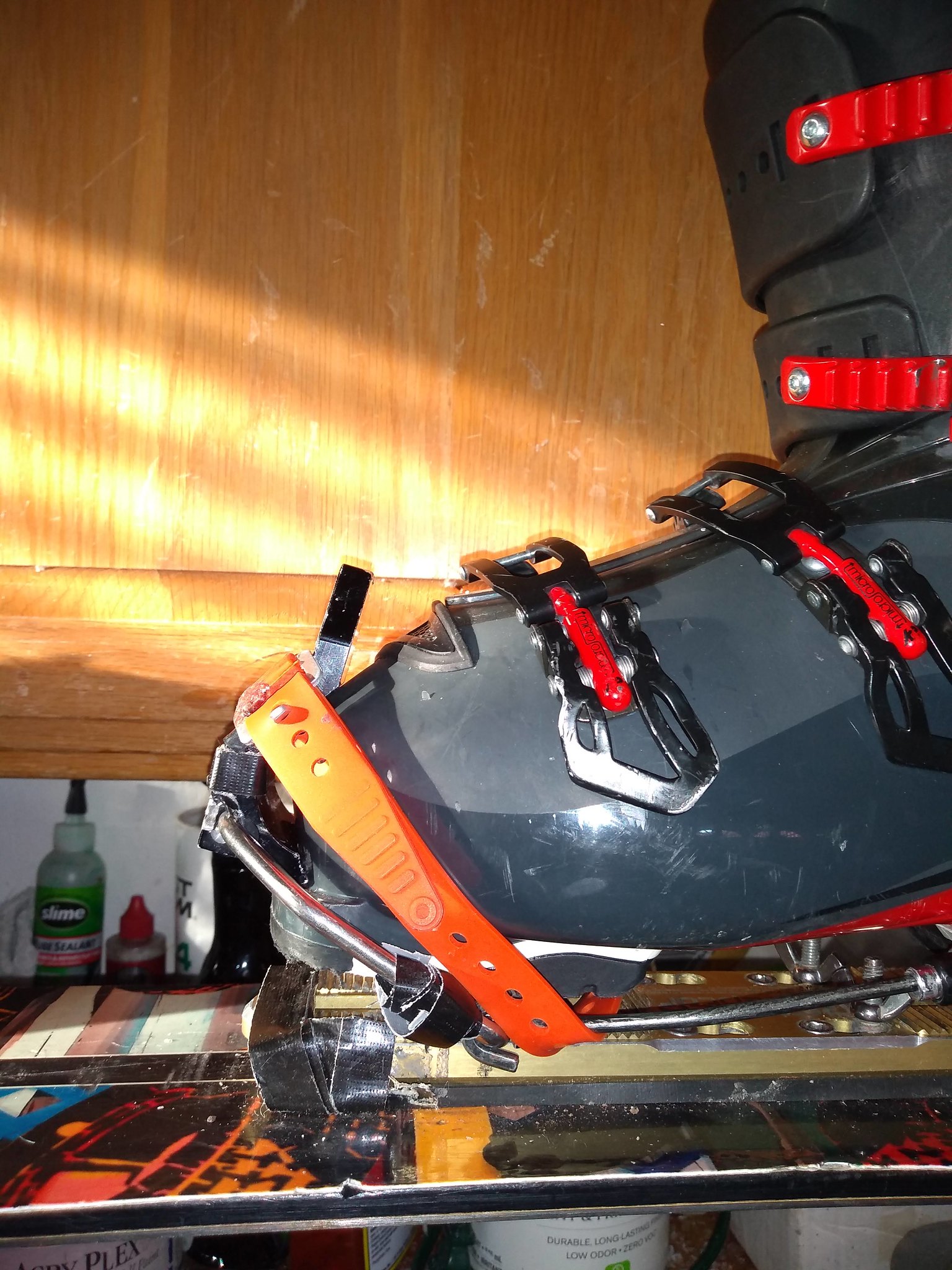 IMG_20201226_083056632 by Jack Jue Jr, on Flickr
IMG_20201226_083056632 by Jack Jue Jr, on Flickr
The plastic 2 inch pvc pipe is attached to the rear bale by a bungee cord . ( I didn't have a piece of pvc pipe for this photo essay so just used a roll of tape to illustrate )
 IMG_20201226_082338564 by Jack Jue Jr, on Flickr
IMG_20201226_082338564 by Jack Jue Jr, on Flickr
To deploy the pvc pipe for climbing just swing it in front of the rear heel piece of the receptor binding
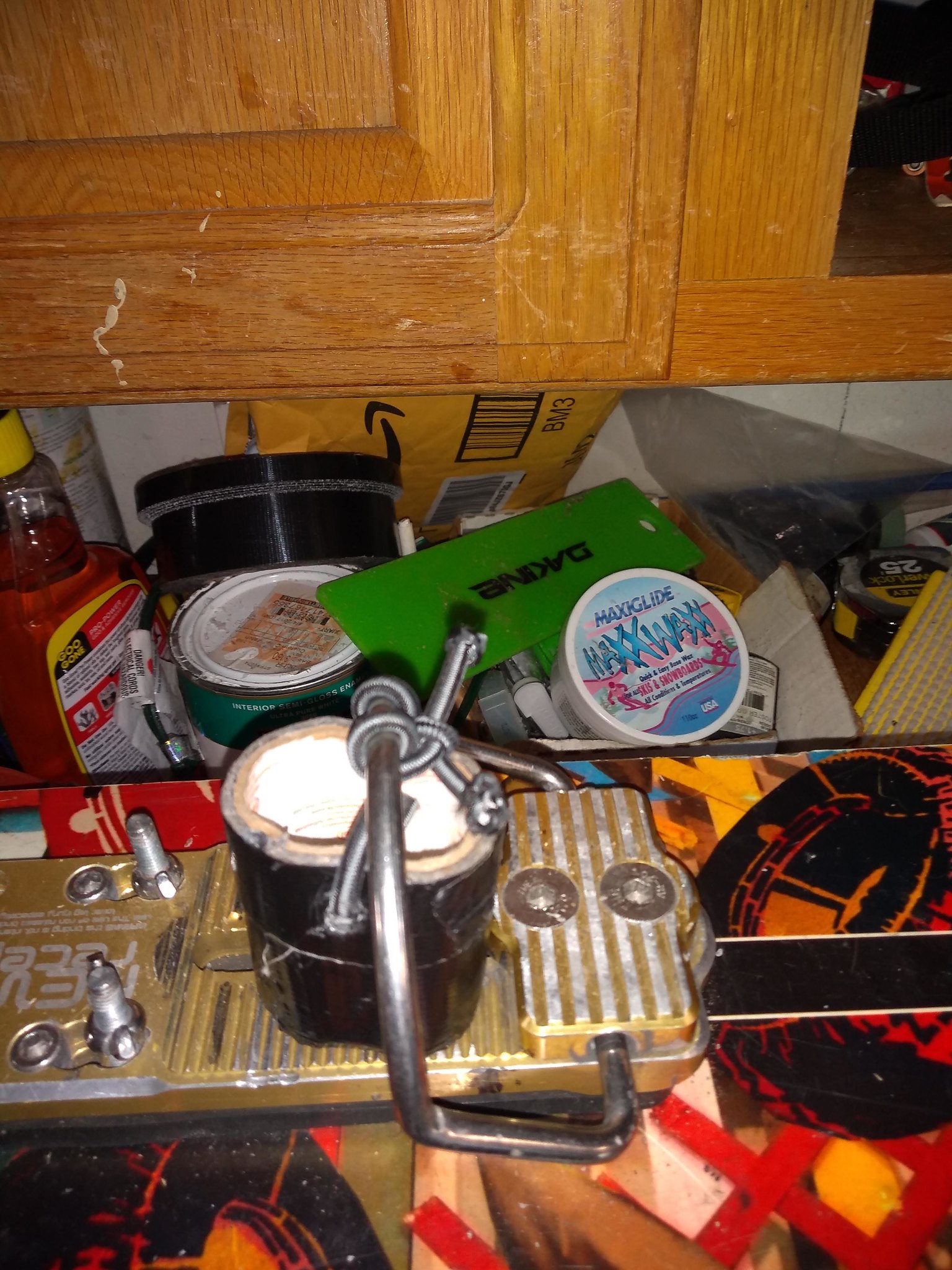 IMG_20201226_082353388 by Jack Jue Jr, on Flickr
IMG_20201226_082353388 by Jack Jue Jr, on Flickr
 IMG_20201226_083120491 by Jack Jue Jr, on Flickr
IMG_20201226_083120491 by Jack Jue Jr, on Flickr
You put on skins and use a skeets mini crampon strapped on if you need to use crampons on icy climbs.
 IMG_20201226_083713736 by Jack Jue Jr, on Flickr
IMG_20201226_083713736 by Jack Jue Jr, on Flickr
 IMG_20201226_083723507 by Jack Jue Jr, on Flickr
IMG_20201226_083723507 by Jack Jue Jr, on Flickr
At the top of the climb remove skins , crampons if used, voile strap and telemark cables and put in your pack..
Then just click in as usual and you are ready to shred The climbing pvc pipe heel elevator just stays attached to heel bale.
 IMG_20201226_083220008 by Jack Jue Jr, on Flickr
IMG_20201226_083220008 by Jack Jue Jr, on Flickr
I am very confident this touring modification will work and am looking forward to trying it out !!!
 IMG_20210117_095228942 by Jack Jue Jr, on Flickr
IMG_20210117_095228942 by Jack Jue Jr, on FlickrBelow is my original post.
I have come up with an easy way to modify the RVL8 receptor binding to allow touring in the backcountry.
Anyone can use their Receptor binding to tour on any RVL8 skiboard by purchasing these commercially available supplies.
2 long Voile plastic straps
2 Voile Telemark cables
2 Two inch tall pieces of pvc pipe drilled with a hole on either side to pull elastic cord through
two pieces of elastic cord
Climbing skins
A pair of Skeats strap on mini crampons.
Here is a picture of the binding in touring mode with heel elevator engaged
 IMG_20201226_082219798 by Jack Jue Jr, on Flickr
IMG_20201226_082219798 by Jack Jue Jr, on FlickrOk here is how to get into the binding in touring mode
you simply attach the hooks of the telemark cables to the front bale of the Receptor binding. I put some duct tape permanently near where the bale bends into the foot plate to keep the telemark cables from shifting when I am getting into the binding.
I lay the voile strap just behind the foot receptor foot plate and then attach the regular front bale and rear telemark cable to my boot.
 IMG_20201226_082304627 by Jack Jue Jr, on Flickr
IMG_20201226_082304627 by Jack Jue Jr, on Flickr IMG_20201226_083029075 by Jack Jue Jr, on Flickr
IMG_20201226_083029075 by Jack Jue Jr, on FlickrI then pull the strap around my boot and around the front bale and tighten the voile strap. This is really what makes this system work because it keeps the front lever
from snapping open on climbing which happened on previous iterations of this binding.
 IMG_20201226_083056632 by Jack Jue Jr, on Flickr
IMG_20201226_083056632 by Jack Jue Jr, on FlickrThe plastic 2 inch pvc pipe is attached to the rear bale by a bungee cord . ( I didn't have a piece of pvc pipe for this photo essay so just used a roll of tape to illustrate )
 IMG_20201226_082338564 by Jack Jue Jr, on Flickr
IMG_20201226_082338564 by Jack Jue Jr, on FlickrTo deploy the pvc pipe for climbing just swing it in front of the rear heel piece of the receptor binding
 IMG_20201226_082353388 by Jack Jue Jr, on Flickr
IMG_20201226_082353388 by Jack Jue Jr, on Flickr IMG_20201226_083120491 by Jack Jue Jr, on Flickr
IMG_20201226_083120491 by Jack Jue Jr, on FlickrYou put on skins and use a skeets mini crampon strapped on if you need to use crampons on icy climbs.
 IMG_20201226_083713736 by Jack Jue Jr, on Flickr
IMG_20201226_083713736 by Jack Jue Jr, on Flickr IMG_20201226_083723507 by Jack Jue Jr, on Flickr
IMG_20201226_083723507 by Jack Jue Jr, on FlickrAt the top of the climb remove skins , crampons if used, voile strap and telemark cables and put in your pack..
Then just click in as usual and you are ready to shred The climbing pvc pipe heel elevator just stays attached to heel bale.
 IMG_20201226_083220008 by Jack Jue Jr, on Flickr
IMG_20201226_083220008 by Jack Jue Jr, on FlickrI am very confident this touring modification will work and am looking forward to trying it out !!!











Comment